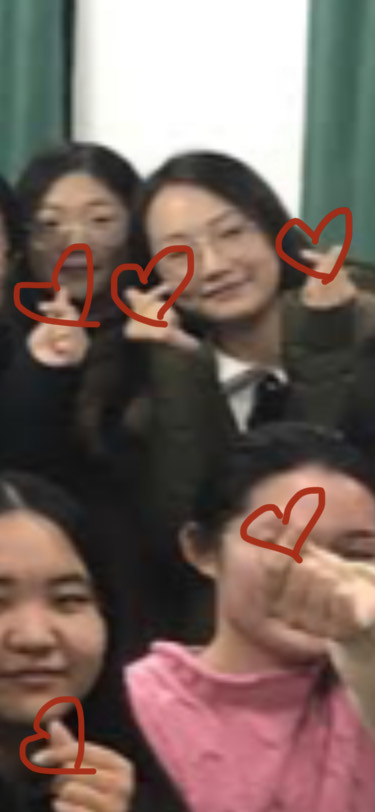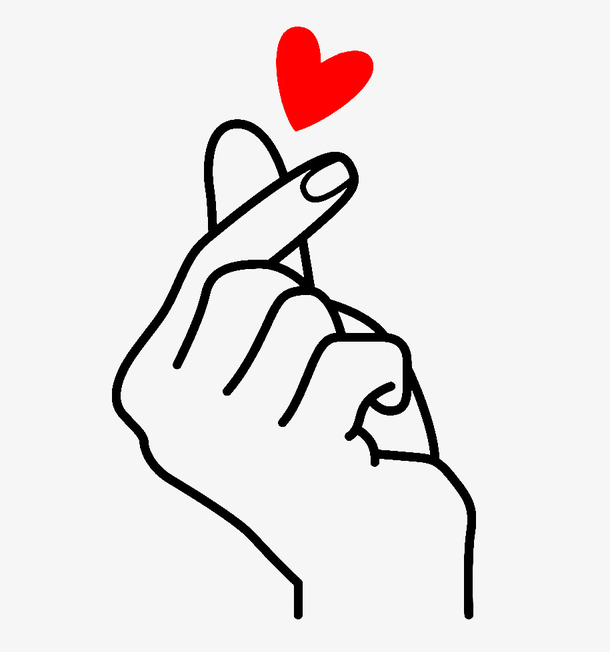The semiotics of an East Asian hand gesture
« previous post | next post »
These days people make all sorts of public and private hand gestures to convey a wide variety of information. Innocent though they may seem, for various reasons many of them become controversial (e.g., the sign for "OK", which has recently been classified by some organizations as a symbol of hate).
These students at a university in China are making the sign of bǐxīn 比心. According to their professor, it means "love you" or "give you my heart".
Here's the same photo with the many heart gestures outlined in red:
And here's a closeup of one section:
The crossed fingers (the thumb and index finger) look like a heart.
Everybody tells me that this sign began in Korea, and then swept across all East Asian countries, and even down into Southeast Asia. In Korean, it is called son hateu 손 하트 ("hand heart") or songarak hateu 손가락 하트 ("finger heart").
For basic information about the heart finger gesture, see here and here.
This gesture quickly became a hot topic in China, because some Chinese idols did not know the meaning of the gesture and did not know how to form it correctly. When American actors of Marvel movies went to Korea, they were also asked to make this gesture, but they did so with a confused look.
Even though the heart hand gesture has been wildly popular in China for several years, bǐxīn 比心 is still a neologism that the three major online translation services — Google Translate, Baidu Fanyi, and Microsoft — fail to render correctly. In contrast, Wiktionary and MDBG do get it right.
The initial confusion over the meaning of bǐxīn 比心 is evident from the fact that the term is also written as bǐxīn 笔芯, which literally means "pen cartridge refill".
Cf. bǐhua 比画 ("gesture; gesticulate; make hand gestures; use sign language"), from which the bǐ 比 part of bǐxīn 比心 derives.
One of my informants says that the heart gesture was brought to China by a Korean singer on a TV show in 2016 and that it quickly became popular throughout China.
Another informant says that it was first frequently used by some South Korean singers, actors & actresses, and other celebrities. Because of Hán liú 韓流 ("The Korean Wave" — the wave of the South Korean pop culture), the gesture entered China around 2010 and became so popular that almost all young people know about it. The heart gesture is definitely one of the most prominent elements of the Korean Wave:
The Korean Wave (Korean: 한류; Hanja: 韓流; RR: Hallyu; MR: Hallyu), a neologism, literally meaning "wave/flow of Korea") is the increase in global popularity of South Korean culture since the 1990s. First driven by the spread of K-dramas and K-pop across East, South, and Southeast Asia during its initial stages, the Korean Wave evolved from a regional development into a global phenomenon, carried by the Internet and social media and the proliferation of K-pop music videos on YouTube.
(Source)
An assortment of remarks on "bǐxīn 比心" from my correspondents:
"Nowadays young girls (and boys) in China are obsessed with this gesture."
"There are many different gestures of 'bǐxīn 比心'. I’m sometimes surprised by how many ways people came up with to make a heart with their hands."
"You can’t believe how crazy people are about this sign. Even my mom is doing it!"
"Today people of Japan and some South Asian countries like Thailand have fallen in love with it."
"People like to use this gesture in photographs, partly replacing the 'V' sign that was ubiquitous in previous decades."
"Since the Korean performers have to hold microphones, they choose this sign which is easy to make with only one hand."
"After the sign was introduced to China, it became popular not only between idols and fans, but also in most other cases by young people, to show their love to each other."
As someone who has been a student of Buddhism throughout my professional career, I cannot help but mention the Indic practice of mudra:
A mudra (/muˈdrɑː/; Sanskrit मुद्रा, IAST mudrā, "seal", "mark", or "gesture"; Tibetan: ཕྱག་རྒྱ་, THL: chakgya, is a symbolic or ritual gesture or pose in Hinduism, Jainism and Buddhism. While some mudras involve the entire body, most are performed with the hands and fingers.
(Source)
Traditional Indic heart mudras are much more complicated than the currently popular East Asian gesture. For images of Indic heart mudras, see here.
[Thanks to Lin Cao, Haewon Cho, Diana Shuheng Zhang, Xinchang Li, Chenfeng Wang, Di Wang, Yijie Zhang, Qing Liao, Yixue Yang, Yishu Ma, Buyun Chen, and Yunzhu Huang]




Frank L Chance said,
December 27, 2019 @ 12:14 pm
Have others noticed that the gesture also can be the result of a finger snap? See for example https://www.youtube.com/watch?time_continue=50&v=Oo3cKxlkQZc&feature=emb_logo
Philip Taylor said,
December 27, 2019 @ 3:21 pm
"When American actors of Marvel movies went to Korea, they were also asked to make this gesture, but they did so with a confused look" — this I find the hardest part to comprehend. Can one really expect a group of people to react favourably to being asked make a sign which signifies "love you" or "give you my heart" ? If the sign is to have any meaning at all, then surely it needs to come from the heart, rather than being a gesture virtually forced on the visitors by their hosts.
Chester Draws said,
December 27, 2019 @ 9:29 pm
e.g., the sign for "OK", which has recently been classified by some organizations as a symbol of hate
This was the work of 4Chan, and is arguably the best internet troll of all time. They literally set out to show that people could be persuaded of any nonsense, provided it was provided in the right, that is "correct", context.
The OK symbol is not, and never has been, a symbol of hate.
TKMair said,
December 28, 2019 @ 10:56 am
This is a great synopsis of hand gestures and how their mass usage hints at some striking differences between 21st century Asian and Western cultures.
Now I want to add something about the hand gesture known as "OK sign." My favorite usage of it is a very specific NBA pro basketball sign to mean 3 points. (Or, I made a 3 pointer). It's a much milder and refined celebratory signal than the super showy score celebrations of another major American sport entertainment. I used to enjoy watching NBA games somewhat but was never truly a huge fan and now I barely watch or know who is playing.
But I do remember the first time I saw the 3 OK sign, and now I am really wishing I could remember the player! I believe it was during the semi finals around the year 2009. And I thought it was a player on the Lakers (personally I did NOT like that team during that era) or the Dallas Mavs (who I did like!). But Googling the rosters for those teams didn't get a picture of the player I'm thinking of. If I saw a picture I would recognize him instantly. He is a guard, darker skinned African American, with very handsome visage and well mannered play style. Sunk many 3s and was all around great team type player.
Anyhow, I saw him sink that 3 from well outside the line, and casually make the OK sign, then bring his hand to his right eye using the circle of the fingers to look through as if through a sniper view. A small moment, but rarely do you see something on television that is that memorable.
And for any basketball fans that have read this far… lately I've been interested in NBA again. Evidently there is a lot of talk about changing the rules about 3 pointer scoring. Statistically, the percentage of 3 points has been steadily rising over the past 2 decades and many people feel that it's ruined the game… Very interesting video about it here
After watching, my thought would be, implement a 3 point score cap for any single game. Like 33 points max. After which any further shots made outside the 3 point line are only worth 2 points. There might be a few less 3 OK celebrations but the inside the paint game could come back to life.
https://youtu.be/wNgX07wvrcQ
Victor Mair said,
December 28, 2019 @ 11:49 pm
As a former basketball player, I must say that I love the 3 point rule, because it rewards skill over sheer physical height.
Victor Mair said,
December 28, 2019 @ 11:54 pm
From an anonymous contributor:
There must be a better word than mudra for hand signal communication. I say that because hand signals are not at all the same thing as mudra.
Mudra are finger positions meant to enact internal influences on the person using them, whether spiritual or physical. They are not meant to be a communication or expression. I'm not saying someone seeing another person doing a mudra does not get a communication from seeing it (sure they do). But generally a person doing a mudra is not trying to communicate anything, they are meditating.
Now, I thought there must be a better word for hand gestures than "hand signaling" but I guess that's the best one ☺.
There's another very interesting place where holding specific hand postures is a key aspect and that is Kungfu, martial arts. There I think it's almost a combination of mudra and hand signaling. The martial artist is definitely both enacting an internal physical pattern for specific reason, and also… in fighting, communicating how dangerous you are is definitely a major part of it. Best fight is the one that never happens!
Mimi K. said,
December 30, 2019 @ 1:49 am
On a plane ride I happened to watch I Am a Singer/我是歌手 — just the episode that your informant was undoubtedly talking about. Little did I know, I was (probably) witnessing history in the making as the judges asked the contestant Hwang Chi-yeul what his finger gesture meant. Most Chinese people I have discussed 比心 with also trace it back to this moment.
As for Philip Taylor's question: In Korea, celebrities often perform "aegyo", i.e., cute little affectionate gestures as fan service. On variety shows and the like, it's pretty common to ask a celebrity to do a certain pose, wink, etc. Fans make GIFs out of them or just feel all warm and fuzzy inside. Korean celebrities are just more "performative" in general in their interactions with the public.